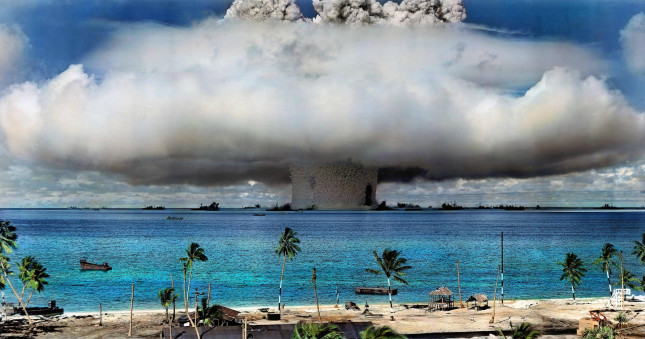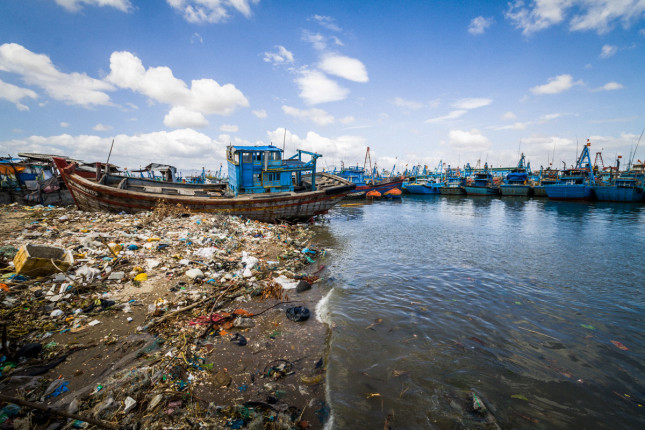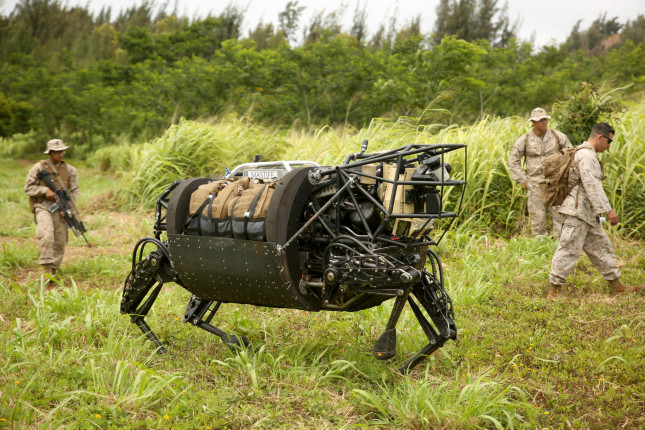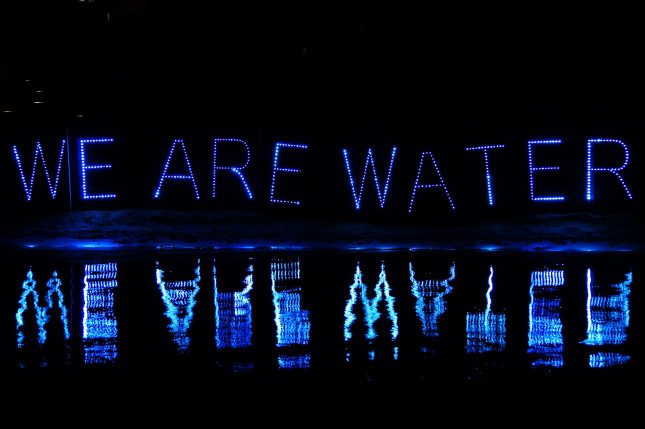The Man Made Apocalypse of Weapon Systems and Climate Change
Our oceans are on the brink of collapse. Decades of pollution, micro-plastic “islands”, and over-fishing have reduced marine stocks and ecosystem to a fraction of pre-industrial levels. Pacific Salmon is undergoing a veritable genocide conducted by humans, Tuna is being fished at rates thousands of times higher than their natural rate of replenishment, and large marine mammals are at their lowest-ever recorded levels. If this weren’t bad enough, imagine a hidden arsenal of millions of tonnes of toxic chemical weapons laying at the bottom of our oceans, waiting to leech into the waters. A veritable cesspool of poisonous sludge made of Mustard and Chlorine gases, arsenic, and a cocktail of other weapon-grade chemicals. The only thing is: you don’t have to imagine it, it’s actually here!
These are the shameful remnants of a dark period in history – an arsenal of biblical proportions, meant to achieve apocalyptic consequences. These weapons were meant to be used by our governments, against the citizens of other nations, to cause mass devastation and death. When they became inconvenient, they were disposed out of sight and, apparently, out of mind. Now the metal crates they are contained in are slowly being corroded, some already have. When the chemicals are released they have devastating consequences: coral reefs and bottom-dwellers/feeders die en-masse; small fish are contaminated first, and the poisons travel up the food chain (including to us humans), entire ecosystems and economic livelihoods collapse. After all, these weapons were devised to annihilate life.
International Dialogue on Underwater Munitions (IDUM)
The truth about, and the appalling size of, this problem only came to light in 2008 following the declassification of a number of previously secret documents of the U.S. Department of Defense. The United States are, however, by far not the only culprits. A lot of the munitions were dumped by former colonial powers along the shores of their former colonies and other developing nations. The major culprits seem to have been France, the U.K and, of course, the United States. Some were also dumped by the USSR in the Baltic and North seas. By far the largest victim was Japan, currently sporting over one hundred disposal sites virtually within throwing distance of its coasts. It seems that humiliating and poisoning Japan’s citizens with two nuclear bombs, the repercussions of which are still felt today, was not enough. Given the seismically active nature of Japan’s location, it is likely that many of the weapons’ containers have already been damaged or ruptured. Now the victims are tasked with the clean-up job, but they argue that it is the perpetrators who should carry that burden as well as the bill.
We don’t really know where many of these weapons actually are, or how many of them there really are. It was standard practice for governments engage in “inadequate documentation of operations at the time of dumping and the subsequent loss or destruction of records”. What we do know is mostly due to the tireless work of concerned activists that have gone over both the declassified documents and the sea floors inch by inch, attempting to identify the exact locations of the dump sites. Leading this effort is Terrance P. Long, a retired Canadian military engineer, who took it upon himself to make the disposal of these hidden weapons his life’s work. He was instrumental in the creation of the international treaty on the disposal of land mines, and has now focused his attention to their underwater counterparts. He has thus created International Dialogue on Underwater Munitions (IDUM) with this goal in mind. The organization attempts to implement binding international regulation that would force the world’s military powers to cease this practice, and to responsibly clean up the damage they have already caused.
One of the problems he has encountered, in his almost decade-long fight, has been the complete lack of public knowledge of the phenomenon – which is not surprising for a 50 year old secret. IDUM has recently launched an information and petition campaign to attempt to educate the general public, and to pressure international institutions to pass binding legislation to mandate their clean-up. When asked why she thought that more attention is not being paid to such issues, Ms. Pyrikova largely held the occult nature of the problem responsible. “Perhaps”, she says, “it is because of the ‘out of mind, out of sight’ mentality” that is the standard in many political arenas. In addition, Ms. Pyrikova cited an additional political obstacle, which is that “before removing these weapons, governments must first admit that they are there, which could be politically costly”. But the problem is far from abstract. In June 2016 the waters around Cape Breton (Canada), near known weapon dump sites, showed high levels of toxic contamination. An explosion in a munition dump in Dover, Delaware (USA), caused bodily injuries to a local fisherman consistent with mustard gas, and destroyed most of the chowder. More recently, French officials from the Meuse region admitted to toxic levels of soil contamination due to old munition dump sites.
All Humans are Victims
This trend is worrying, and we have no idea if it was a past practice or an enduring one. An investigation by the United States’ DoD reveals that “munitions are present on thousands of current and former Department of Defense sites, encompassing millions of acres”. A 2008 report cites “millions of tonnes” of weapons on our sea-floors, and the IDUM itself has estimated the figure to reach at least one million. However, “every new site discovery is likely to bring that estimate up”, says Diana Pyrikova, the managing director of IDUM. However, it is not the sole danger posed to our oceans by the Military industry and war. What can be sure is that the militarization of the oceans is the next big frontier in warfare and armaments development – after all, oceans cover two-thirds of the planet’s surface and much more of its volume, and it is said we know more about the surface of the moon than we do about the bottom of our oceans. The health of our oceanic waters is rapidly deteriorating, and the major military powers of the world are contributing greatly to it.
Already, NORAD is developing underwater drones, Russia has developed fully-functional automatic weapons for underwater warfare, and China is considering the construction of an “Underwater Great Wall”. These are all examples of the expansion of the military industry in one of the last frontiers, but perhaps the most striking one is to be found in the U.S. Navy’s operations in the Gulf of Mexico. Starting from 2014 and planned to continue until 2019, experiments are being conducted with high-powered sonar and explosive detonations. According to their own impact assessment report, these could both seriously injure and kill marine life (especially large mammals), and be responsible for mass-stranding (they likely already have). A sonar uses sound for echo-location much as whales and dolphins do. Blasts at the levels the Navy is testing, if they don’t kill the whale on the spot, are very likely to render them temporarily or permanently deaf, which is no difference – a deaf whale is a dead whale. While a recent lawsuit has forced the U.S. Navy to reduce its operations in affected areas, the Department of Defense is expected to seek further legal appeals on that decision, and to continue its operations regardless.
Historically as empires expanded, the peoples and territories at its periphery would be ravaged and pillaged. When an empire based on industrial civilization and modern warfare expands, the non-human life and the environment are often the first and most ignored victims. The expansion of militarism by the world’s superpower into our oceans, and the fight for supremacy in this last unexplored domain, are the very last factor that could tip the oceanic balance over the edge. In this context, the work of entities like the IDUM is essential. “The chemicals in these weapons will have almost completely leached into the ocean in 10-15 years”, said Ms. Pyrikova, “we have a very short window of time in which to act”. After that, it will be too late, and one more serious blow will have been dealt to our global oceanic ecosystems. In the absence of action by our own governments, it is up to regular citizens, activists, and concerned scientists to exert political pressure on their representatives and demand this issue to be resolved.
Editor’s Notes: Photograph one from International Campaign to Abolish Nuclear Weapons archive; photograph two by Vadim; photographs three, six and eight by Joe Brusky; photographs four and seven from DVIDSHUB‘s archive; photograph five from the Wisconsin National Guard archive.
Related Articles






















You must be logged in to post a comment Login